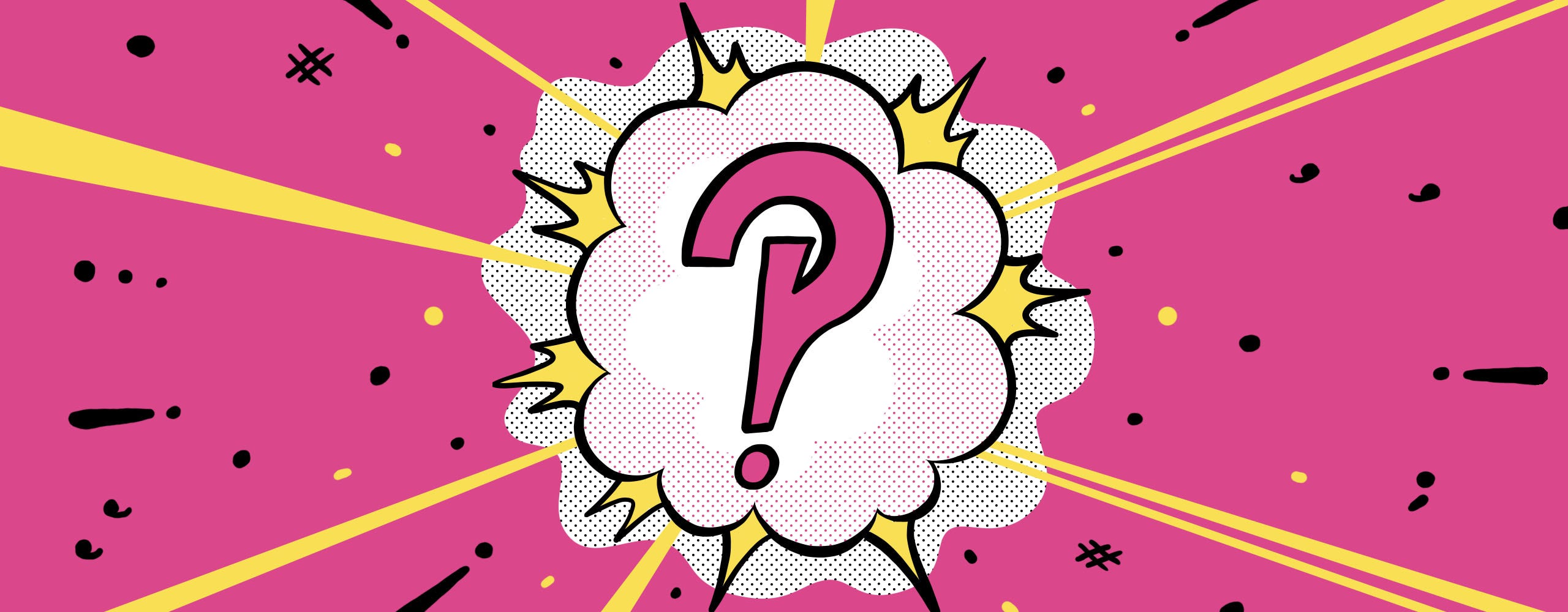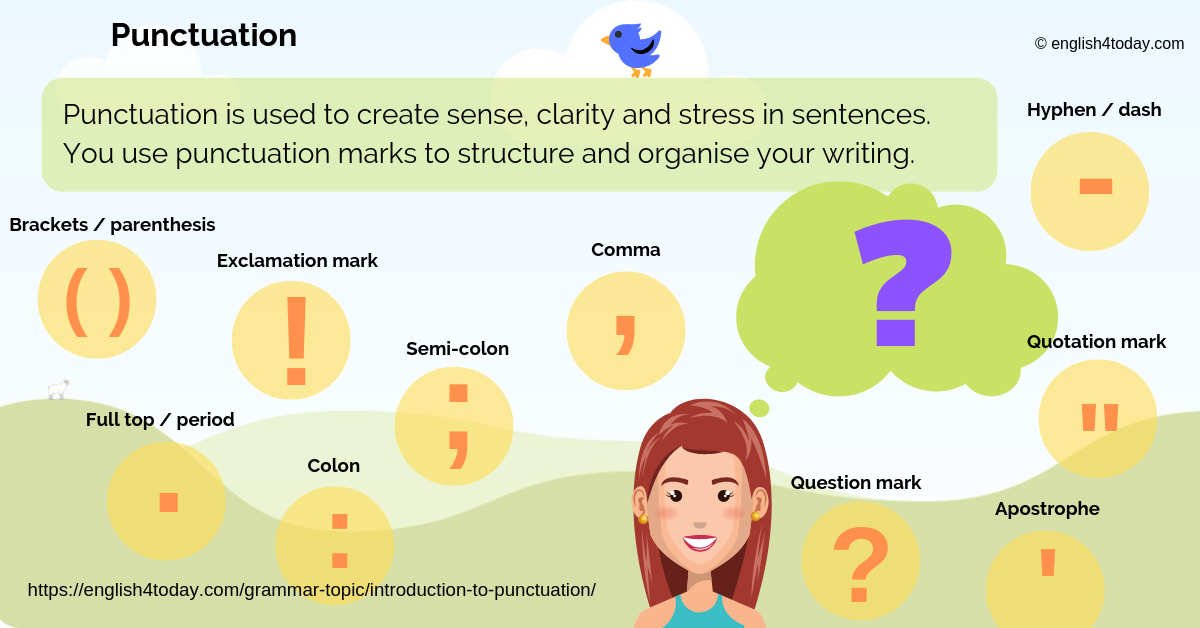Punctuation mark definition is - any of various standardized marks or signs used in punctuation. The web's most comprehensive guide to American punctuation. Rpg maker free.
Q&aall islamic content in one placemat. Punctuation Introduction; Punctuation. Punctuation Overview; Punctuation in Sentences; Sentence Punctuation Patterns; Independent and Dependent Clauses. Independent and Dependent Clauses; Run On Sentences; Conquering the Comma Presentation; Commas. Commas: Quick Rules; Extended Rules for Commas; Commas After Introductions; Commas. Punctuation is the system of signs or symbols given to a reader to show how a sentence is constructed and how it should be read. Sentences are the building blocks used to construct written accounts. They are complete statements. Punctuation shows how the sentence should be read and makes the meaning clear.
Can you imagine a paragraph without any periods or commas? In truth, it would be almost unreadable. There are 14 punctuation marks in English grammar, and, at minimum, one of them has to appear in every sentence, never mind every paragraph, to make it easily understood.
The good news is, with fourteen different punctuation marks to choose from, variety will remain the spice of life. Follow these 6 basic punctuation rules and they will help you to write more clearly and effectively.
1. Punctuation Must be Parallel
When punctuation is parallel it means that interrupting a main clause with a dash or a comma requires the same punctuation at both the beginning and end of the clause.
- Incorrect: The teenagers, students from Mrs. Smith's art class-went on a field trip to the museum.
- Correct: The teenagers, students from Mrs. Smith's art class, went on a field trip to the museum.
- Correct: The teenagers-students from Mrs. Smith's art class-went on a field trip to the museum.
This rule also means that you should not use a semicolon to set off just one item in a list.
- Incorrect: I have lived in Des Moines, Iowa, Seattle, Washington; and Boise, Idaho.
- Correct: I have lived in Des Moines, Iowa; Seattle, Washington; and Boise, Idaho.
2. An Emdash is a Strong Comma
An emdash (the longest of the three dashes) can be used for many of the same purposes as a comma. A pair of emdashes might be used if the sentence already contains commas. Similarly, it might be used to mark off information for emphasis. An emdash can also act alone, drawing attention to a modifier or an extra piece of information. Here are a few examples:

- Sarah hated walking to school-it was all uphill-but she had no choice, she had missed the bus again.
- For his birthday, Mark received a sweater, a jacket, a savings bond-and a new bike!
- Pizza, chocolate, and ice cream-these are my favorite foods.
3. A Colon Appears at the End of a Main Clause
If you have trouble deciding when to use a colon in your writing, it helps to ask yourself if a period or question mark would be appropriate in the same location. If the sentence is already complete, you may use a colon to add a list, elaboration, or restatement.
- List: I have three brothers: David, Kent, and Jacob.
- Elaboration: I have decided not to move to San Francisco: I have been offered a better job in Milwaukee.
- Restatement: Thinking back, Jenny wasn't sure who started yesterday's fight: she couldn't decide whether she was at fault or her friend Annie.
4. A Semicolon is Used for Equal Emphasis
In a compound sentence that has no coordinating conjunction, a semicolon can join related independent clauses that are of equal importance.
- Sarah answered my question abruptly; she seemed preoccupied.
A semicolon can also be used before a conjunctive adverb joining two clauses in a compound sentence.
- The restaurant was very crowded; however, the waitress took our order immediately.
5. Parentheses Show Related, Nonessential Elements
Parentheses can be used to show elements in a sentence that are related but not necessary to understand the meaning of the sentence. Parentheses can be replaced by commas in most cases, although the use of parentheses tends to de-emphasize a piece of information.
- My family visited several countries (Italy, France, Portugal, and Spain) on our vacation last year.
If the information inside the parentheses forms a complete sentence within the larger sentence, no punctuation is necessary.

Punctuation Rules
- The snow (April saw it when she passed the window) completely covered the trees.
6. Apostrophes Show Possession or Indicate an Omission
An apostrophe is used to show possession or ownership. An apostrophe and an -s should be added to singular possessive nouns, plural possessive nouns that do not end in -s, and singular possessive nouns that end in -s. Only an apostrophe should be used when showing possession or ownership for a plural possessive noun that ends in -s.
- Singular possessive noun: Susan's book
- Singular possessive noun ending in -s: Chris's car
- Plural possessive nouns: the children's school
- Plural possessive noun that ends in -s: my parents' house

An apostrophe can also be used to show that a letter has been omitted from a word to form a contraction. For example, 'they're' is a contraction of 'they are' and 'it's' is a contraction of 'it is.' (Note that 'its' is a possessive pronoun.)
Punctuation Rules
Now that you've got the basic punctuation rules under your belt you're ready to tackle your problem areas. Be it commas, semicolons or apostrophes that troubles you, YourDictionary has a wealth of in-depth punctuation knowledge right at your fingertips. Anything you'd like to learn to use more effectively is here for the taking.
So, get excited! Your paragraphs are about to be bulked up with colons, emdashes, and parentheses the likes this world has never seen. Happy writing!
Punctuation Quizzes
Basic | Intermediate | Advanced
Punctuation is the system of symbols that we use to separate written sentences and parts of sentences, and to make their meaning clear. Each symbol is called a 'punctuation mark'.
Punctuation Marks
The following table of commonly used English punctuation marks shows:
- a graphical representation of each punctation mark (black) with text block (grey)
- name of punctuation mark with link to more information
- very simple example sentence (more examples on individual pages)
| punctuation mark | name | example |
|---|---|---|
| full stop or period | I like English. | |
| comma | I speak English, French and Thai. | |
| semi-colon | I don't often go swimming; I prefer to play tennis. | |
| colon | You have two choices: finish the work today or lose the contract. | |
| hyphen | This is a rather out-of-date book. | |
| dash | In each town—London, Paris and Rome—we stayed in youth hostels. | |
| question mark | Where is Shangri-La? | |
| exclamation mark exclamation point (AmE) | 'Help!' she cried. 'I can't swim!' | |
| slash, forward slash or oblique | Please press your browser's Refresh/Reload button. | |
| backslash | C:Filesjo.doc | |
| double quotation marks | 'I love you,' she said. | |
| single quotation marks | 'I love you,' she said. | |
| apostrophe | This is John's car. | |
| underline | Have you read Harry Potter? | |
| underscore | b_l@cia.gov | |
| round brackets | I went to Bangkok (my favourite city) and stayed there for two weeks. | |
| square brackets | The newspaper reported that the hostages [most of them French] had been released. | |
| ellipsis mark | One happy customer wrote: 'This is the best program..that I have ever seen.' |
Punctuation Styles
Although there are general rules for English punctuation, there can be differences of style. For example, some people don't put a full stop (period) after abbreviations (Dr, Ltd); others do (Dr., Ltd.). Some people don't use an apostrophe in the plural form of dates (1990s); others do (1990's). Some prefer single quotation marks ('example') rather than double quotation marks ('example').
These differences in punctuation style can be found between:
Punctuation Definition
- Individual writers
Here it may be just a matter of personal preference. - Publishers
Most newspapers and book publishers have their own 'house rules' (also called 'style guide') that include specifications on the exact style of punctuation that they want their writers to use. - British and American English
There are a few distinct differences between British punctuation (increasingly called 'logical punctuation') and American punctuation. The table below outlines the most common of these. Click on a link for more details.
| British/American punctuation | BrE | AmE |
|---|---|---|
| BrE includes punctuation inside quotation marks only if part of the quoted material | Helpful means 'ready to help'. | Helpful means 'ready to help.' |
| BrE tends to use more 'open punctuation' for abbreviations | Mr, Mrs, Dr, Rd | Mr., Mrs., Dr., Rd. |
| The ( ) symbols are called | brackets | parentheses |
| The [ ] symbols are called | square brackets | brackets |
The above differences are shown as guidelines only, and are not always observed. The most important thing in any single work (be it examination essay, business report, newspaper or book) is to choose one style and be consistent throughout.
Punctuation Worksheets
Anyone seeking guidance at an advanced level is recommended to consult a style guide (often included in good dictionaries) for their particular variety of English or editorial style. Style guides for newspapers and other publications are often available on the Internet and may be found by searching for '[name of publication] style guide' or similar.
See also: Typing Signs and Writing Symbols, e.g. * # & % $
Punctuation Rules
- Index of Punctuation Marks
